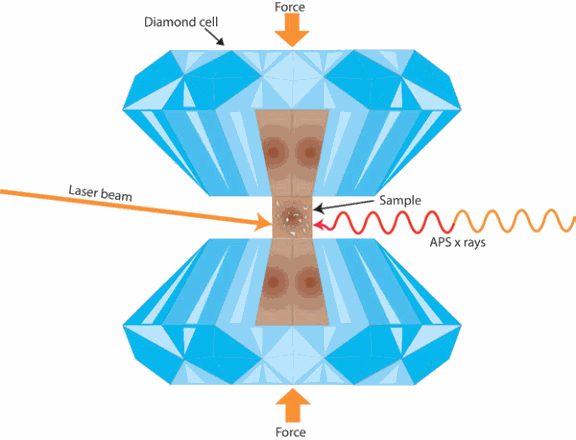Materials deep inside the Earth have unexpected atomic properties that might cause scientists to revise their models of Earth’s internal processes. That’s the finding reported by a team of researchers carrying out experiments at an x-ray beamline at the U.S. Department of Energy’s Advanced Photon Source (APS) at Argonne National Laboratory.
The researchers recreated in the lab the materials, crushing pressures, and infernal temperatures they believe exist in the lowermost mantle, nearly 2,900 kilometers (1,800 miles) below Earth’s surface. Their study, published in the journal Nature Geoscience, reports that the materials exhibit rare and unexpected atomic properties that might influence how heat is transferred within the Earth’s mantle, how columns of hot rock called “superplumes” form, and how the magnetic field and heat generated in Earth’s core travel to the planet’s surface.
The planetary building blocks magnesium, silicon, oxygen, and iron are the most abundant minerals in the lowermost mantle. The researchers, from Lawrence Livermore National Laboratory, KFKI Research Institute for Particle and Nuclear Physics, Argonne National Laboratory, The University of Chicago, the Geophysical Laboratory of the Carnegie Institution of Washington, and Universität Bayreuth, led by Jung-Fu Lin of The University of Texas at Austin’s Jackson School of Geosciences, synthesized materials from these building blocks in a diamond anvil cell (DAC), a device containing two interlocking diamond pieces that squeeze the sample like a vise. They subjected the sample to more than 1.3 million times the standard atmospheric pressure. Shining a laser through the transparent diamonds, they then heated the sample to almost 3,000 degrees Celsius (5,400 degrees Fahrenheit) for several days.
The scientists used a GeoSoilEnviro Center for Advanced Radiation Sources x-ray beamline at the APS to collect data using the x-ray emission spectroscopy and x-ray diffraction techniques, and an X-ray Operations and Research beamline at APS Sector 3 for synchrotron Mössbauer spectroscopy. They determined that the high pressures from the DAC had caused some of the electrons in the sample’s iron, which normally repel each other, to “pair up” or become bound to each other. Earlier experiments by Lin and others had found evidence for areas in the lower mantle in which electrons were either mostly paired up or mostly unpaired. This was the first evidence of a broad region in the subsurface with what scientists describe as “intermediate-spin state,” or partially paired iron electrons.
“We were surprised to find partially paired electrons,” said Lin. “That doesn’t normally occur in other geological materials that we know about.”
The degree of electron pairing, also known as electronic spin state, can affect how well the materials conduct heat and electricity. Lin said modelers who make computer simulations of mantle dynamics will now have to go back and try to determine how this intermediate-spin state might affect the way heat is transferred within the Earth, how superplumes form, how convection occurs in the mantle, and how Earth’s magnetic field might radiate from the core.
The electronic spin state can also affect the speed of seismic waves traveling through material in the deep mantle. As a result, seismic images of the lowermost mantle—collected when earthquake vibrations travel through and reflect off of material in the subsurface—may have to be reinterpreted.
Contact: J.-F. Lin, [email protected]
See: Jung-Fu Lin, Heather Watson, György Vankó, Esen E. Alp, Vitali B. Prakapenka, Przemek Dera, Viktor V. Struzhkin, Atsushi Kubo, Jiyong Zhao, Catherine McCammon, and William J. Evans, “Intermediate-Spin Ferrous Iron in Lowermost Mantle Post-Perovskite and Perovskite,” Nat. Geosci., published online 14 September 2008. DOI:10.1038/ngeo310
The original Jackson School of Geosciences press release can be found here.
Use of the Advanced Photon Source was supported by U.S. Department of Energy (DOE), Office of Science, Office of Basic Energy Sciences, under contract No. DE-AC02-06CH11357. GSECARS is supported by NSF Earth Sciences (EAR-0622171) and DOE Geosciences (DE-FG02-94ER14466). This work at Lawrence Livermore National Laboratory was carried out under the auspices of the DOE by Lawrence Livermore National Laboratory under Contract DE-AC52-07NA27344. J.F.L. was partially supported by the Lawrence Livermore Fellowship. G.V. acknowledges financial support from the Hungarian Research Fund (OTKA) under contract No. K72597 and from the Bolyai Fellowship. V.V.S. acknowledges financial support from DOE.

